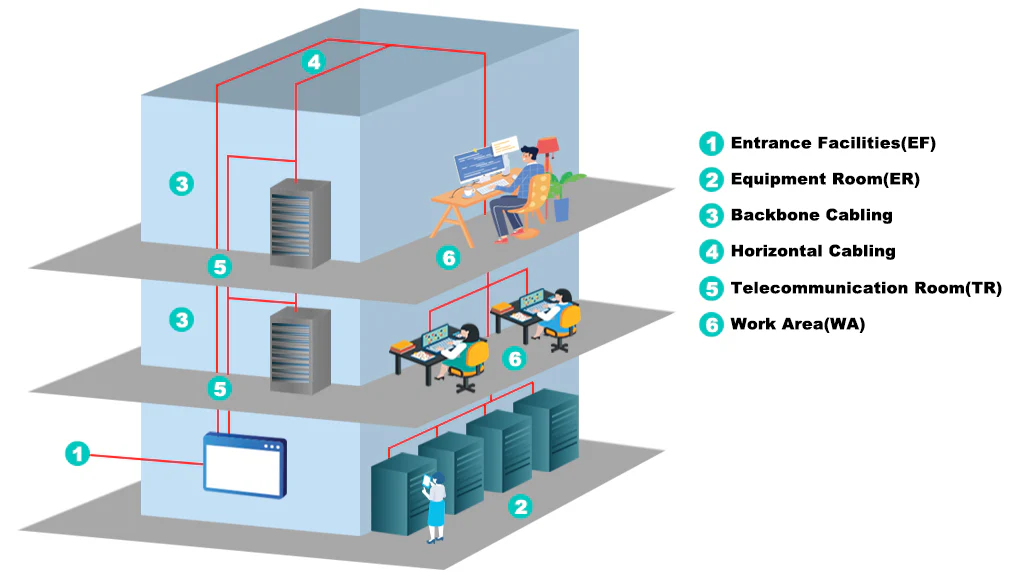Structured Cabling and Fiber Optics: The Backbone of a Reliable and Future-Proof Network
In today’s fast-paced digital world, businesses rely on high-speed, reliable networks to maintain operations, communicate with customers, and stay competitive. As businesses grow and technologies evolve, the demand for faster data transmission and more efficient network infrastructure becomes critical. At the heart of any robust IT system lies structured cabling and fiber optics—the backbone of a modern, scalable network.
Whether you’re building a new office, upgrading existing infrastructure, or planning for future growth, investing in structured cabling & fiber optics ensures your network can handle current demands and adapt to future technological advancements. In this article, we’ll explore why structured cabling and fiber optics are essential for business success and how they support faster, more reliable networks.
1. Understanding Structured Cabling: The Foundation of Network Infrastructure
Structured cabling refers to the standardized network infrastructure that connects various devices in a building, including computers, phones, security systems, and more. Unlike traditional point-to-point cabling, which can become tangled and disorganized, structured cabling follows a streamlined approach, organizing cables in a way that makes them easy to manage, troubleshoot, and upgrade.
Key Components of Structured Cabling:
- Horizontal Cabling: Connects individual workstations and devices to the network through telecommunications rooms.
- Backbone Cabling: Connects different rooms or floors in a building, creating a strong and centralized network backbone.
- Patch Panels: Allow for organized connections and make it easy to move, add, or change network devices.
- Cabling Pathways: Cable trays, conduits, or raceways that ensure cables are organized and protected.
By installing structured cabling, businesses ensure that their networks are scalable and flexible, allowing for easy upgrades as technology changes. Whether it’s adding new devices, expanding to different floors, or increasing bandwidth, structured cabling supports these changes without needing a complete overhaul.
2. Fiber Optics: Unlocking the Power of Speed and Bandwidth
While structured cabling provides the physical organization of a network, fiber optics delivers the speed and bandwidth needed to support modern business operations. Fiber optic cables use light to transmit data, allowing for much faster speeds and greater bandwidth compared to traditional copper cables.
Advantages of Fiber Optics Over Copper:
- Faster Data Transmission: Fiber optics can transmit data at speeds up to 100 Gbps or more, far exceeding the capabilities of copper cables. This makes fiber optics ideal for businesses with high data transfer needs, such as video conferencing, cloud computing, or large-scale data backups.
- Greater Bandwidth: Fiber optics provide significantly more bandwidth, allowing businesses to handle multiple data streams simultaneously without slowing down. This is essential for companies using real-time applications like VoIP, streaming, or remote collaboration tools.
- Long-Distance Transmission: Fiber optics can transmit data over much longer distances without degradation, making them ideal for businesses with multiple locations or large office spaces.
- Immune to Interference: Unlike copper cables, which can be affected by electromagnetic interference (EMI) or radio frequency interference (RFI), fiber optics are immune to such disruptions, ensuring a more stable and reliable connection.
With the increasing reliance on cloud services, IT managed services, and remote work environments, having a high-speed, reliable network is more important than ever. Fiber optics provide the speed and bandwidth needed to support these technologies without compromising performance.
3. The Role of Structured Cabling & Fiber Optics in Business Growth
As businesses expand, their IT infrastructure needs to grow with them. Structured cabling and fiber optics offer the flexibility and scalability to support future growth without requiring a complete redesign of the network. Whether you’re adding new employees, adopting new technologies, or expanding to new locations, a robust network infrastructure ensures that your business can continue operating smoothly.
Supporting Business Expansion:
- Easy Upgrades: Structured cabling allows businesses to add new devices, increase bandwidth, or integrate new technologies without redoing the entire cabling system. Patch panels and centralized cabling systems make it easy to add new connections as needed.
- Accommodating New Technologies: As businesses adopt emerging technologies like the Internet of Things (IoT), artificial intelligence (AI), or cloud-based applications, structured cabling and fiber optics ensure that these systems can be integrated seamlessly into the existing network.
- Cost-Effective Growth: While the initial investment in structured cabling and fiber optics may be higher than traditional cabling, the long-term cost savings are substantial. Businesses can avoid costly network overhauls and enjoy the benefits of a system that can grow with them.
Investing in structured cabling & fiber optics from providers like Complex Security Solutions, Inc. ensures that businesses have a network infrastructure designed to support growth, improve efficiency, and reduce long-term costs.
4. Enhancing Network Reliability and Reducing Downtime
Downtime is a costly problem for any business, leading to lost productivity, revenue, and customer satisfaction. A well-designed network infrastructure with structured cabling and fiber optics significantly reduces the risk of network failures or slowdowns, ensuring that your business stays online and operational.
Why Structured Cabling Improves Reliability:
- Simplified Troubleshooting: Structured cabling systems are organized and labeled, making it easy for IT teams to identify and fix issues quickly. This reduces the time it takes to resolve network problems and minimizes the impact on business operations.
- Redundant Pathways: In larger networks, structured cabling allows for the creation of redundant pathways, ensuring that if one cable fails, there is an alternative route for data to travel. This redundancy is especially important for businesses that rely on continuous uptime.
- Higher Quality Connections: Fiber optics provide a cleaner, more reliable signal compared to copper cables, reducing the risk of data loss or corruption. This is particularly important for businesses that rely on high-quality video or voice communications.
By investing in reliable structured cabling & fiber optics, businesses can avoid the costly consequences of network downtime and keep their operations running smoothly.
5. Supporting IT Managed Services and Advanced Technologies
As businesses increasingly rely on IT managed services and cloud-based technologies, the need for a robust, high-speed network becomes even more critical. Structured cabling and fiber optics provide the backbone for these services, ensuring that businesses can fully leverage the benefits of advanced technologies without compromising performance.
How Fiber Optics Support IT Services:
- Fast Access to Cloud Applications: Cloud computing has become a staple for many businesses, offering flexible access to software, data storage, and collaboration tools. Fiber optics ensure fast, reliable access to these cloud services, allowing businesses to operate efficiently.
- Seamless Integration with Security Systems: Modern businesses rely on integrated security systems, including access control and security cameras, to protect their assets. These systems depend on a reliable network to function properly, and fiber optics provide the speed and bandwidth needed to support real-time monitoring and control.
- Supporting Remote Work: With more businesses adopting remote work policies, the need for a strong, reliable network is more important than ever. Fiber optics allow employees to access company resources, collaborate with colleagues, and communicate with clients without experiencing slowdowns or connectivity issues.
By ensuring that their network infrastructure can support IT managed services and other advanced technologies, businesses can stay competitive and efficient in today’s digital landscape.
6. Future-Proofing Your Network Infrastructure
One of the most compelling reasons to invest in structured cabling & fiber optics is the ability to future-proof your network. As new technologies emerge and businesses continue to evolve, having a network infrastructure that can easily adapt is essential for long-term success.
Preparing for Future Technologies:
- 5G Integration: As 5G technology becomes more widespread, businesses will need networks capable of handling higher data speeds and increased connectivity demands. Fiber optics provide the bandwidth needed to integrate 5G services seamlessly into existing networks.
- IoT Expansion: The Internet of Things (IoT) is expected to revolutionize industries, from manufacturing to healthcare. A network infrastructure built on structured cabling and fiber optics ensures that businesses can adopt IoT devices without overwhelming their existing systems.
- Increased Data Demand: As businesses collect more data and rely on analytics to drive decision-making, the demand for high-speed data transmission will only increase. Fiber optics are designed to handle these demands, ensuring that your network can grow alongside your business.
With the right network infrastructure in place, businesses can confidently adopt new technologies and stay ahead of industry trends.
Conclusion
Structured cabling and fiber optics are more than just technical solutions—they are the foundation of a successful, future-proof business. By investing in a reliable, scalable network infrastructure, businesses can ensure that they have the speed, flexibility, and reliability needed to support growth, reduce downtime, and embrace emerging technologies.
By partnering with experts like Complex Security Solutions, Inc., businesses can design and implement network infrastructures that are built to last, ensuring their operations stay competitive and efficient for years to come.



